16. Feb 2021 - DOI 10.25626/0125
Nelly Bekus, is an associated lecturer at University of Exeter, UK. She previously held research posts at Harvard University, the Institute of Human Sciences in Vienna, and the University of Warsaw. She is author of Struggle Over Identity: The Official and the Alternative Belarusianness (CEU Press 2010), and co-authored Orthodoxy Versus Post-Communism? Belarus, Serbia, Ukraine and the Russkiy Mir (Cambridge Scholars, 2016). She also co-edited a special issue of International Journal of Heritage Studies entitled ‘Heritage, Socialism and Internationalism after 1945. The Second World and Beyond’ (2020). Her works have been published in the Theory and Society, British Journal of Sociology, Journal of Multilingual and Multicultural Development, Europe-Asia Studies, and Nationalities Papers.
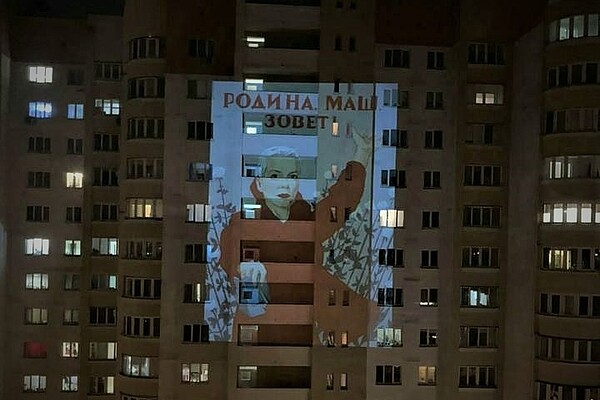
The 2020 mass protests in Belarus have been seen by some as a reiteration of 1989, when revolutions brought about regime change in numerous countries across Central and Eastern Europe. The glimmer of a glorious moment – as people took to the streets to break with the communist past – appeared across various Western and Eastern European media reports, which reflected on the “Echo of 1989 Hanging over Belarus” or considered “How Europe can help Belarus through its 1989 Moment”.[1] In his weekly Sunday video address shared on Twitter, Czech Prime Minister Andrej Babiš remarked that, “Belarusians must not to be afraid to implement the Velvet Revolution model of November 1989.” Arguably one of the most spectacular symbolic extensions of 1989 into current Belarus was the ‘Baltic Way 2020’: On 23 August, some 50,000 people – Lithuanians and Belarusians living in Lithuania – created a 32-kilometre long human chain from Vilnius to the Belarusian border. The initiative was meant to demonstrate solidarity with Belarusian protesters and to celebrate the anniversary of the 1989 Baltic Way, when two million Lithuanians, Latvians, and Estonians joined hands in a human chain that connected the three capital cities of Tallinn, Riga and Vilnius in an attempt to remind the world of the Soviet aggression perpetrated against the independent Baltic states in 1939 and to demand freedom from the Soviet Union.[2] Since 2008, 23 August has been recognized as the official “European Day of Remembrance for Victims of Stalinism and Nazism” commemorating the victims of mass deportation and extermination. For the Baltic countries, it is a day of dual remembrance, commemorating both the loss and the regaining of independence. The human chain of solidarity from Vilnius to Belarus in August 2020 thus offered a clear interpretive framework for the events occurring in Belarus in which they represented both a break from post-Soviet space and the beginning, however delayed, of its own anti-communist revolution.
By taking a closer look at the existing records of protest mobilizations and marches in Belarus, this article explores how and what type of memories and historical associations were employed by the protesters themselves in order to communicate a message about their identity, their values and the ideas for which they stand to a wider audience. It explores the expressive symbolism of the marches, as demonstrators deployed numerous cultural and historical parallels to shape their image and to reassert core attributes of worthiness, virtue, and commitment.
There is no doubt that the emancipatory appeal of the Belarusian protests is similar to the one that sustained the 1989 revolutions. The ways in which the memory of the Soviet past have been used by protesters, however, do not follow the ready-made Eastern European template of anti-Soviet mobilisation. One of the distinct features of the 2020 Belarusian protest, which distinguished it from both the 1989 Baltic and Central European revolutions and the 2014 Euro-Maidan in Ukraine, is the continued relevance of the memory of the Great Patriotic War (as the Second World War is known in post-Soviet countries). In the Baltic states and Ukraine, the Soviet narrative of the war was replaced by an alternative nation-centred vision, which framed the conflict as a clash between two totalitarianisms during which each of these countries emerged as a victim of both sides. Conversely, Belarusian demonstrators remain committed to a memory and narrative of the war against Nazi Germany, which supplies them with a sense of righteousness and triumphant heroism.
Since Belarus gained independence in 1991, the discursive terrain of Belarusian identity and memory politics has featured two parallel, co-existing projects. An oppositional discourse was endorsed by multiple political and cultural actors (most prominent among them the Belarusian Popular Front, its youth branch, the Young Front, and the Belarusian Christian Democrats) whose political and cultural programmes advanced a strategy of post-Soviet othering – that is, of distancing from and reckoning with the Soviet past. The forced liquidation of what was perceived of as the vestiges of the Soviet system – including the use of the Russian language and the Soviet interpretation of Belarusian history – was considered an essential component of the ongoing project of nation-state building. Echoing the dominant trope of Central and Eastern European post-communism, the Belarusian ethnonationalist narrative transformed the issue of Stalinist repression into a story of (ethno-)national suffering. By contrast, the official identity discourse that gradually took shape after Alyaksandr Lukashenka came to power in 1994 promoted an idea of the Belarusian nation-state that in many respects was a continuation of the Soviet development model. Lukashenka launched a project of nationalizing the Soviet past that aimed to reappropriate that past in order to position the Belarusian nation as the subject of its twentieth century history, rather than as one of its victims.[3] The history of building the Soviet Belarusian republic, fighting against Nazi Germany and rebuilding life after the war, came to be retold as the story of how Belarusians became a modern nation.
One of the distinctive features of the 2020 election campaign was the absence of the “old” oppositional players and their political agenda, which included the revival of the Belarusian language, a historical reckoning with the Soviet past, and promotion of a geopolitical reorientation towards Europe. None of the opposition presidential candidates – among them the founder of the popular YouTube channel Strana dlya Zhizni (A Country for Life), Siargey Tikhanousky, the former head of Belgazprombank, Viktar Babaryka, and the founder of the Belarus Hi-Tech Park, Valery Tsepkala – had any connection with the political parties that represented the established political opposition. They emerged onto the political stage calling for Belarusians to reflect on the deteriorating conditions of daily life and appealing to their understanding of political normality. They raised questions that reflected the worries of citizens independent of ideological affiliation, such as the accountability of governing elites, or the lack of transparency in decision-making. The ultimate leader of these voices and of the anti-government protests became Sviatlana Tikhanouskaya, who registered as a presidential candidate as a stand-in for her imprisoned husband and was supported by campaigners initially tied to Victar Babaryka or Valery Tsepkala. The massive protest mobilisation in the summer of 2020 was, however, not the result of effective political campaigning by what online media soon dubbed the “three graces” – Sviatlana Tikhanouskaya, Maryia Kalesnikava and Veranika Tsepkala,[4] but was the product of systemic popular dissatisfaction with the existing political situation in the country and a growing demand for change. Tikhanouskaya’s program contained only three major promises: to stop police violence, to release political prisoners, and to organize new free and fair presidential elections.
The nature of the Belarusian protests is indeed different from those that took place in other post-Soviet states. The country displays neither extreme poverty, nor aggravated social inequality, nor a radical anti-Russian nationalism. The driving force of the protests, instead, derives from the fact that, in this modern, developed and technologically advanced society, people do not want to be governed by overt autocratic means and to have their voices ignored and their opinions suppressed. The escalating violence unleashed by the regime against peaceful protesters in the days and weeks after the rigged elections not only exposed Lukashenka’s unwillingness to accept this fact, but also stripped his stay in office of any remaining legitimacy. The use of stun grenades, water cannons, and rubber bullets along with the rocketing number of arrests – when many of the arrested have been detained for no obvious reason other than being on the street – further exposed the determination of Lukashenka to stay in power against people’s will.
The broad variety of social groups that joined the protests reflected a broad swath of society – from IT professionals, businesspeople, and doctors, to academics, students, sportspeople, workers, and pensioners – including many women and many who had never participated in political demonstrations before. This massive influx of political newcomers created a new social context for the protests, in which the cultural and political symbols that were previously involved in the struggles between authority and opposition, were reappropriated and reshuffled, creating a new kind of blended symbolism of protest.
The Belarusian repertoire of contention became a product of a creative adaptation of a variety of globalized patterns and forms of protest by employing familiar local idioms, symbols and memories. Singing the song Mury (“Walls”) was a reverberation of an anthem chanted by the Polish Solidarność in the 1980s. This song was the creation of Polish songwriter Jacek Kaczmarski, who, in 1978, translated and adapted it from the original Catalan song L’Estaca (“The Stake”), written in 1968 by Luis Llach. The collective performance of the song Magutny Bozha (“Mighty God”) on the platforms of Minsk metro stations and at shopping centres appears like a Belarusian echo of Hong Kong protesters singing “Glory to Hong Kong” at shopping malls and airport terminals in defiance of the Chinese government.
Forming human chains, with clear reference to ‘the Baltic Way’ of both 1989 and 2020, became one of the repeated rituals of the Belarusian protest employed in a variety of ways. Women organized solidarity chains along the streets of Minsk in August 2020 to express their solidarity with detained protesters, demonstrating the consolidation of female protesters and their peaceful call to stop the police violence and torture in prisons targeting men. The commemorative pattern of the Baltic Way was also “borrowed” by Zmitser Dashkevich, the former leader of the Young Front, who organized a “human chain of repentance” on 21 August 2020 that connected the Kurapaty memorial site and the detention centre where most of the arrested protesters were detained, located on Akrestsina street (named after the Soviet pilot who died near Minsk in 1944). Since 1988, the mass burial site at Kurapaty has become central to the effort of Belarusian national activists to construct a narrative of the Belarusian collective subject as a victim of Soviet ‘genocide’.[5]The poster promoting the chain “Kurapaty Akrestsina. Never Again”, published online on Novyi chas, draws a direct causal link between the crimes of Stalinism and present-day violence in Belarus: “Kurapaty and Akrestsina are a single chain, and even symbolically, it is one road – Kurapaty at the beginning of it, Akrestsina – in the end”, it reads. Below the poster, Dashkevich calls on people to join the chain:
Today, many in Belarus think that this [violence] has nothing to do with the crimes committed for 70 years by communists and 26 years by false [Lukashenka] rule. … But Kurapaty is the beginning of what we see today.
Kurapaty also became the main destination of the Dziady Suprats Teroru (Dziady against terror) protest march on 1 November 2020. Dziady in Belarus is a traditional day in memory of the ancestors that had acquired particular political meaning during Perestroika, when, in 1988, the Belarusian Popular Front revived this commemorative tradition. Every year since Belarusian independence, Dziady was marked with a march of remembrance to Kurapaty, organized by the political opposition and various memory activists.
On 29 October, another commemorative event was organized in Kurapaty: “The Night of Executed Poets” was dedicated to the memory of the members of the Belarusian cultural elite, who had been arrested on that day in 1936 and later killed by the NKVD. This remembrance initiative began four years ago, when contemporary Belarusian writers and poets came to Kurapaty to read verses written by poets who had died during the Stalinist purges of the 1930s. In 2020, actors from the Kupalauski theater, which has played a prominent role in the protests, as well as members of other groups active in the protests, including musicians, academics, doctors, sportspeople, journalists, and students joined the reading. Many protesters who had been temporarily detained at Akrestsina in 2020 also came to Kurapaty to take part in the commemoration and read the verses of those who suffered from political violence in 1937.[6] In addition to these more subtle references, direct comparisons and connections between Stalinism and the present-day violence also appeared on protesters’ posters, including one that read: “My grandfather was in the Gulag in the twentieth century. His grandson was in the Gulag in the twenty-first century.”[7]
From the perspective of the political and memory activists associated with the old opposition, these commemorative initiatives and historical references to the Stalinist period have achieved two important goals: On the one hand, they reinforce the parallels between the current repression of the Lukashenka regime and the Stalinist purges, which have been at the centre of the political opposition’s struggle for the last 26 years. On the other hand, the mnemonic practices developed by the “old political opposition,” which condensed and promoted their broader political agenda of deploying the memory of communism in the consolidation of a national narrative, acquired a much broader societal appeal. These practices managed to engage a wide range of individuals and groups of protesters – many of whom had never before participated in the memory work of the political opposition – in acts of remembrance.
One of the most pertinent symbols of pre-2020 oppositional politics that would come to play a central role in current protest imaginaries was the white-red-white flag. This should, however, not be read as a symbol for the ideological victory of the old opposition; in reality, the flag has been reinvented as an emblem of the struggle for Belarus without (or after) Lukashenka, offering an open frame for the socio-political and cultural choices that the people of Belarus will be able to make in the future.
One of the most representative images of the 2020 Belarusian protests was a photograph of the first mass street rally on 16 August, attended by over 200,000 protesters. The photograph shows protesters occupying large tracts of space surrounding the site of the Museum of the History of the Great Patriotic War on Victors’ Avenue in Minsk, with the white-red-white flag draped around the ‘Motherland’ sculpture, which forms an integral part of the Museum’s architectural ensemble. This image does more than show the unprecedented scale of the protest mobilisation in Minsk; it summarises the essence of the transformation of historical symbols taking place over the course of these protests. The 2014 construction of a new venue for the War Museum reflected the prominent role bestowed upon the memory of this war in the memorial landscape of independent Belarus and in the official Belarusian identity discourse in general. Since its opening, the new museum has begun to play a key role in official mass events, such as the annual parades organized on Victory Day on 9 May or on Independence Day on 3 June.
Wrapping the Motherland sculpture in the white-red-white flag can be read as a performative act within an illustrative assemblage: two previously conflicting frames – the flag as the symbol of anti-Soviet nationalism and the sculpture of the Motherland at the Museum of the History of the Great Patriotic War as the embodiment of “the glorious Soviet past” – have been combined in a representation of the new Belarus emerging from (or during) the current protests. In this potent act of re-signification, the heroic pathos of place – reinforced by the iconic, 45-metre-high ‘Hero City of Minsk Obelisk’ (Abelisk Minsk Horad Heroi) – transferred a sense of historical Belarusian heroism to the protesters, who now stand for the victory over the Lukashenka regime.
The regime’s defenders quickly understood the powerful appeal of this symbolic message: in the following weeks, the entire area was surrounded by barbed wire and patrolling police forces. The Obelisk, however, continued to play an important role in the spatial dynamics of the Sunday marches over the next two months. During this period, the protests in Minsk were organized as “star marches”, which start at several different points and converge at a central location. Despite its police protection, the Obelisk remained the central destination for columns of people marching from different parts of Minsk – until 11 October, when, for the first time, the police forced protesters to change their route or disperse, preventing them from achieving their symbolic destination.
The changes in the spatial dynamics of the marchers further reflect the power of the historical imaginary of the Great Patriotic War: once unification of the various columns on Victors’ Avenue became impossible, the next protest march on 18 October was moved to Partisan Avenue and renamed the “Partisan March”. In Belarus, the self-image of the “Partisan Republic”, which had played an important role in defending the Soviet Union and enabling the victory over Nazism, became the defining feature of the post-war polity. Allusions to the history of the partisan movement continued to play an important role in the cultural landscape of independent Belarus. There are, for example, Belarusian media resources and art projects that have adopted the term “partisan”, such as the online news portal The Belarusian Partisan and The Magazine of Contemporary Belarusian Culture P_Art_tisan. The image of a partisan republic evokes the notion of a people capable of both surviving even under occupation and waging an efficient and, ultimately, victorious battle against an alien power. Nexta, a Telegram channel that became a crucial platform for organizing and coordinating protest marches, made clear reference to this narrative frame in its announcement about the changes to the march on 18 October:
Partisans come to the march [….] to demonstrate that we, the descendants of glorious warriors and partisans, are worthy of our ancestors, who once defeated fascism.
Commenting on the transfer of the protest march to Partisan Avenue in an interview to Belsat TV, one participant discussed the strategic benefits of the location change by using categories drawn from partisan warfare: “the police have gotten to know the areas surrounding the Obelisktoo well, it became too easy for them to arrest people there. Changing places means they will have less orientation on the new terrain and it will be easier to escape.” Another protester commented on the success of the protest march: “We walk like partisans, like victors.”
Similar transfers of the Soviet heroic symbolism to the 2020 protests could be observed on 17 August, when, during the protests, the bas-relief at the foundation of the Lenin monument on Independent Square in Minsk that depicts the 1917 October Revolution was decorated with the white-red-white flag. The act invoked the symbolism of the ongoing protests as a new revolution, set to bring down the old regime and open a new page in Belarusian history.
Imagery from the Second World War became an important resource for raising the morale of Belarusian protesters, appealing both to a narrative of victory and to a sense of righteousness encrypted in the Belarusian memory of the War. The important role played by women in the Belarusian protest events was reflected in an art project by photographer Vika Zhukouskaya. In an artistic photograph, Motherland is Calling, a woman stands in white dress with red paint spilled on it with her arm raised in a gesture reminiscent of the famous Rodina-Mat’ zovyot! monument erected in Volgograd in 1967, dedicated to the heroes of Stalingrad. Another artwork, by Anna Redko, depicts one of the leaders of the Belarusian protests, Maryia Kalesnikava, in a poster entitled “Motherland, Masha, Calls” that evokes the Second World War poster “The Motherland is Calling”. Instead of a leaflet with the military oath, which appeared on the original poster, Anna Redko’s image depicts Maryia Kalesnikava with her torn Belarusian passport in hand. It refers to the story of her attempted expulsion from the country by Belarusian special forces on 8 September 2020, which she prevented by tearing up her passport. Followed by her immediate detention, this act of resistance was praised by opponents of Lukashenka as a manifestation of unprecedented courage and determination in standing up to the regime. Redko’s work became one of the images projected on high-rise buildings in residential districts across Minsk.
The historical image of the partisans was also adopted by several groups within the Belarusian IT community, which declared a “cyber-partisan” war against the Lukashenka regime. Their most famous operations have included the blockade of the Ministry of Internal Affairs website and the open access publication of a database containing the personal details of serving police riot officers. On 26 September, the cyber-partisans hacked the website of Belarusian state TV channels ONT and BT in order to broadcast videos of the dispersal of peaceful protests in Minsk, which have never previously been shown on these state-own channels. In addition, activists opened up a new theatre in the Belarusian cyber-partisan war by designing a computer program that used artificial intelligence to “unmask” law enforcement officers involved in violence against peaceful protesters.[8] The creator of the programme, Andrei Maximau, stated that this technology was part of a wider initiative aimed at revealing the identities of officers in the hopes that the prospect of losing their anonymity would make them reflect on the consequences of their despicable behaviour. The program became instrumental in the creation of the “Black Book of Belarus”, announced by Sviatlana Tikhanouskaya in Vilnius in October 2020, the title of which alludes to the Black Book of Communism, a work put together in the 1990s by an international group of historians to document the crimes of communism.[9]The project’s Telegram channel collects documented information on violence and other types of abuse perpetrated against protesters during the protests.
As a result of the rapid politicisation of a variety of actors, representing diverse districts and intersecting social groups, the Belarusian protests activated a process of re-signification of the cultural and political symbols previously embedded in the struggle between official and oppositional ideologies. The protests created a unique space for social and cultural interactions, in which identities and meanings were able to be reshaped, blended, and changed, sweeping away the rigid system of opposition that divided the country’s cultural and political space. Over the course of the protests since August 2020, the previously oppositional discourse of a nationhood consolidated the remembrance of the victims of Stalinism has acquired an unprecedented societal appeal, as the commemorative events at the Kurapaty memorial site demonstrate. Remembering the victims of Stalinist crimes, however, did not result in a full-scale alienation from the Soviet legacy, as was the case in the post-communist period of other Central and Eastern European countries. It became one of many elements in a multi-directional system of historical and cultural reference point, which consolidated a language able to relate the past experiences of police violence, torture, and abuse to the present. The memory of the Great Patriotic War, previously associated with official memory and identity politics, has been effectively reappropriated by the protesters, supplying them with a heroic imagery that serves to forge an assertive identity for those determined to bring down the Lukashenka regime.
Nelly Bekus: Historical Memory and Symbolism in the Belarusian Protests. In: Cultures of History Forum (16.02.2021), DOI: 10.25626/0125.
Copyright (c) 2021 by Imre Kertész Kolleg, all rights reserved. This work may be copied and redistributed for non-commercial, educational purposes, if permission is granted by the copyright holders. For permission please contact the editors.
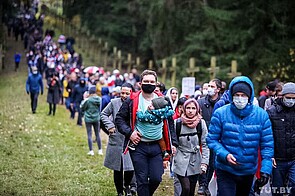
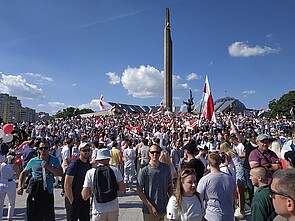

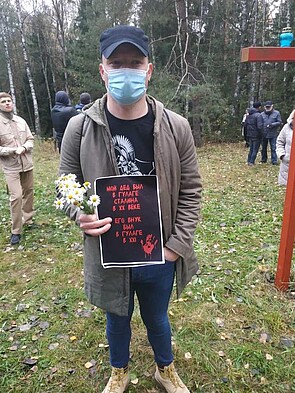
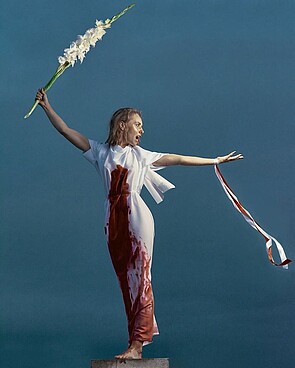
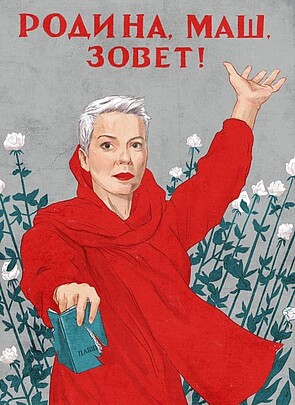
Nelly Bekus · 27.09.2019
Between a National and a Global Mnemonic Agenda: Memory Activism Around the Kurapaty Memorial Site i...
Read more
Iryna Kashtalian · 11.03.2015
Strangers at Home: Memorialisation of the Armia Krajowa in Belarus
Read more
Aliaksei Lastouski · 07.05.2014
Belarus - In the Tight Embrace of the 'Russian World': Belarusian Reactions to Events in Ukraine
Read more
Get this article as PDF download (including pictures).